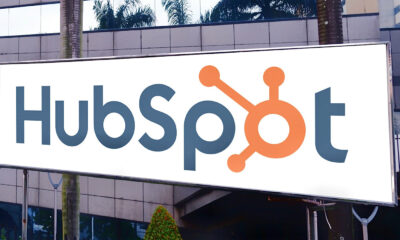MARKETING
Strategizing Your Instagram Marketing – DigitalMarketer

The social network landscape is constantly changing, and Instagram is currently the fastest growing social network. There are 1 billion active users on Instagram, so it’s no surprise that marketers should take part in this growing phenomenon.
While Facebook, Twitter, and LinkedIn are still great ways to connect with customers and build relationships, Instagram is quickly becoming one of the most important social media channels for businesses.
Instagram is especially great for small businesses that want to increase their customer base without spending much money on advertising. It’s also an excellent platform for B2-B companies looking to reach potential customers in their industry.
With that in mind, we will go through eleven quick tips today that will help you improve your Instagram marketing. You will learn to write great captions, engage with your followers, and utilize other Instagram tools to grow your business.
Create An Instagram Business Account:
You probably already have a personal account, but you need to create a separate business account if you want to promote and sell products on the platform.
A business account gives you access to tools that make it easier to manage your profile, including analytics and insights that can help you grow your audience.
Additionally, you can use it to share photos with your customers and fans and engage with them more personally.
You can get one by following these steps:
- Go to www.instagram.com/business/. Click on “Create an Account” in the top right corner of the page.
- Fill out all the required information on this page (e-mail address, username, and password).
- Select whether your business will be verified or unverified (verified accounts are recommended).
- Choose whether you want to link your Facebook page with your new Instagram account (do this if you have one).
Once all of these steps have been completed successfully, you’ll be able to log into your new business account.
Identify Your Ideal Audience:
The first step to any successful marketing campaign is knowing who you’re selling to. While Instagram’s user base is more prominent than ever before, it’s still a very niche platform. Determine who is most likely to buy from you and what they are looking for.
This can be done by looking at the demographics of your target customer base and identifying their interests and behaviors.

The above analytics shows everything age, gender, and most active times so businesses can engage with their audience more effectively.
And once you have identified your target audience, it’s time to tailor your content accordingly. This means creating content that appeals specifically to those users rather than posting the same thing across multiple platforms or accounts.
Tell A Compelling Story:
Storytelling is one of the most effective ways of connecting with people and building an emotional connection with them. It can be used in advertising campaigns, product descriptions, and even social media content.
The best brands on Instagram have a compelling story that speaks directly to their audience and makes them want to engage with the brand.
The key thing is knowing what kind of story will resonate with your target audience. Here is an example of @coastalcollectivemarketing agency:

Coastalcollectivemarketing is a digital marketing agency. This brand sells various services to its clients. To make their audience engage with their brand on a personal level, they are sharing a back story on this post.
The story should be easy to understand and delivered in an interesting way that appeals to different kinds of people, including those who aren’t familiar with your industry or products yet.
Write A Bio:
Writing an Instagram bio can feel like a daunting task when you think about how many people will read it, but your bio is essential to creating a successful profile on Instagram.
Not only your Instagram bio is the place to make a great first impression, but it is also a place to appeal directly to your target audience and showcase your brand voice.
When you have a clear idea of why you’re using Instagram, it becomes easier to write a bio that communicates who you are, what you do, and why people should follow you.
You have 150 characters in your bio. To make it outstanding, try adding the following:
- Include a call-to-action (CTA) if possible
- Write short copy that’s easy for followers to read
- Be authentic and transparent with your brand voice
- Include relevant keywords to your industry
- Use hashtags
Here is an example of a Content Marketing Institute Instagram bio:

As you see, the Content Marketing Institute community made it clear in just a few words who they are, what they do, and what benefit you will get from paying a visit to the site.
Write Great Captions:
One of the best ways to get more comments on Instagram is to write a good caption. Captions can be up to 2,200 characters long and include emojis and 30 hashtags. That’s a lot of space to work with!
However, writing a good Instagram caption can be challenging and tricky. After all, your followers are bombarded with posts from friends and family every day, so how can you make them stop and pay attention to what you have to say?
Here is a trick you can use to write an outstanding caption:
The first thing to consider when writing a caption is your audience. Who is going to read this caption? The caption should be catered towards them and what they will find interesting.
Here is a great example of @Whole30recipes:

Take a look at the caption. It explains almost everything about the image you need to know. For example, it shares the ingredients and uses a convincing tone that makes you want to try this recipe out.
This is the amount of information that you should include in your caption section to engage your existing and new audiences.
Use Eye-Catching Images:
Some of the best Instagram accounts are those that use eye-catching images. This is especially true for accounts that post regularly and have a large following. Posts with images stand out from the crowd and attract more attention than those without them.
It’s because, before anything else, the audience will be looking at the image. And in that first split second, they decide whether they want to continue reading (scrolling) or move on.
To stop people from scrolling and get them to read your text and take action on it, you will need some attention-grabbing images that describe the business you are running.
Let’s take a look at an example:

Here is an excellent example of all that I mentioned above. Travel & Food blog uses outstanding images describing the purpose of their Instagram blog. You don’t need to read any captions to understand that.
Use Related Hashtags:
Another easy way to increase Instagram’s audience is by using related hashtags.
Hashtags are used on Instagram to search for content and are critical to growing your account. In fact, posts with hashtags receive 12.6% more engagement than those without them.
Hashtags are words or phrases that describe a post. And since Instagram is a visually-driven platform, it makes sense that visual content like photos and videos would be categorized by hashtags.
By using relevant hashtags on your posts, you can reach new people who don’t follow you on Instagram yet but are interested in seeing content like yours.
The example of @dunkindonutsperu makes it easier to comprehend:

Here are some effective ways to use hashtags for your business:
Related hashtags: Use hashtags that relate directly to your niche and expertise.
Specific hashtags: Be as clear as possible when using hashtags, especially if you’re in a crowded niche.
Branching out with geographical and lifestyle-based hashtags: Using these can help you reach new audiences by making your brand more relatable to people who aren’t already familiar with what you do.
Try looking at top Instagram blogs in your niche and see what kind of hashtags they use more often.
Geotag In Posts:
One of the things Instagram does, which is so great for travelers and photographers, is to allow you to Geotag your Instagram posts. Using geotags on Instagram is a great way to gain followers.
Because people are interested in what’s going on around them, they may search for posts in their area, and if you’re posting them, they will be able to see your content. This helps increase engagement with your content.
If you are on Instagram to help users find your business or brand, geotagging is also a great way!
Here is a great example by @GloriaJeans to look at:

Gloria Jeans is an international coffee shop. Here in this post, you see they are using location tags to help visitors know where they can benefit from this fantastic offer!
How to geotag your Instagram post?
Step 1: On Instagram, click on the filter icon below the caption field. When you do, you will notice an option to add your location. Tap “Add Location” and type in the name of the area you want to geotag with.
Step 2: When choosing a location, make sure it is associated with your content. For example, if you post a photo of the Golden Gate Bridge, then tag that specific landmark or place.
Step 3: Once you save your image and post it, your Instagram followers can now see exactly where you are when they view your photos in their feeds.
Keep Your Audience Engaged:
Followers are important, but engagement is even more valuable. If you want people to take action on your posts, whether buying something or commenting on your content, you need to make sure they’re paying attention and are engaged with what you’re posting.
The best way to do this is by creating relevant and timely content. For example, if your brand is launching a new product, share the news immediately so that your followers will be notified.
@MINISO is doing a great job over here:

Get creative with your posts, and keep them fresh so that followers continue seeing value in what you have to say.
Another excellent way for brands to engage with their followers is through contests and giveaways.
Use Instagram Stories:
Instagram Stories are a way to share moments from your day in a slideshow format that disappears after 24 hours. They’re great for sharing short, quick moments of your life, such as what you’re doing or where you are.
You can use the Instagram story feature to enhance and add value to the content you wrote on Instagram. So, if you have recently published a post, it’s a good idea to share some key takeaways or behind-the-scenes footage of the piece being created as part of your Instagram story.
Here are three ways to create stories for your Instagram blog:
- Share The Main Points Of Your Post
- Create A Q&A Session
- Test Content Ideas
Build Relationships With Other Users:
Building an Instagram following takes time and dedication, but just like any other social network, it can be a great place to connect with people in your niche and build relationships with other users.
Here are some ways you can use to connect with users:
Follow people in your industry:
This is a good way to build relationships on Instagram. Go ahead and follow people who are doing the same thing as you. If they don’t follow you back, that’s okay; it’s nothing personal!
Once they receive your follow request, they’ll likely visit your page and see what your account is all about. If they like what they see, they’ll probably follow you back.
Comment on others’ posts:
Commenting on others’ posts is an easy way to get noticed and show them that you care about their content.
Make sure your comment isn’t generic and will stand out amongst the rest. For example, “Love this” or “Awesome photo” won’t help much.
Like other people’s photos:
Liking photos might seem like a simple task, but it can make a big difference in building relationships on Instagram. By leaving likes, you give them a reason to notice you and visit your account.
Conclusion
If I have not disclosed the fact already, there are many avenues above that you can take advantage of to market your business on Instagram.
Hopefully, you got some insights from the tips above to help you further your Instagram marketing tactics.










![Holistic Marketing Strategies That Drive Revenue [SaaS Case Study] Holistic Marketing Strategies That Drive Revenue [SaaS Case Study]](https://articles.entireweb.com/wp-content/uploads/2024/09/Holistic-Marketing-Strategies-That-Drive-Revenue-SaaS-Case-Study-400x240.png)
![Holistic Marketing Strategies That Drive Revenue [SaaS Case Study] Holistic Marketing Strategies That Drive Revenue [SaaS Case Study]](https://articles.entireweb.com/wp-content/uploads/2024/09/Holistic-Marketing-Strategies-That-Drive-Revenue-SaaS-Case-Study-80x80.png)


You must be logged in to post a comment Login